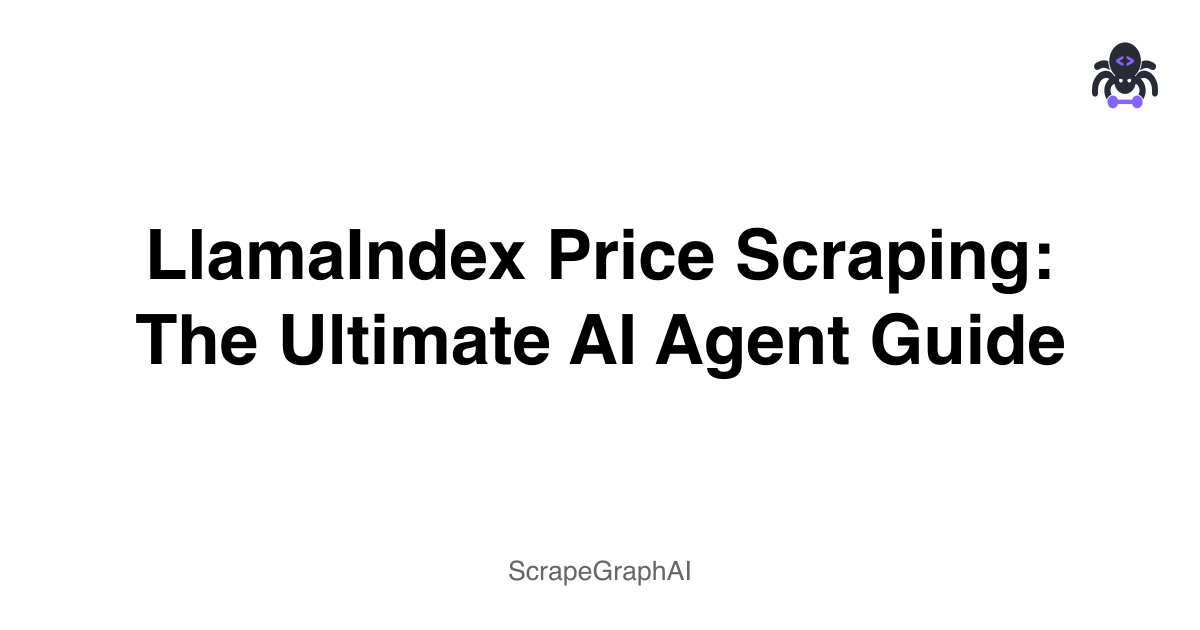Building an AI Price Scraper with LlamaIndex and ScrapeGraphAI
Ever wished you could automatically track competitor prices without manually checking dozens of websites? I've been there - refreshing tabs, copying prices into spreadsheets, and somehow always missing the best deals. What if I told you there's a way to build an AI agent that does all this automatically?
Today, I'll show you how to combine LlamaIndex and ScrapeGraphAI to create a smart price scraping system that actually works.
Why AI for Price Scraping?
Traditional web scrapers break when websites change their layout. You spend more time fixing your scraper than actually using the data. AI-powered scraping is different - it understands context, adapts to changes, and can handle the messy, dynamic websites that plague traditional scrapers.
Think of it like having a really smart assistant who can look at any website and instinctively know where the product names and prices are, even if they've never seen that site before.
The Tools We'll Use
LlamaIndex: Great for organizing and making sense of the data we scrape. It's like having a smart filing system for your scraped information.
ScrapeGraphAI: The actual scraping engine that uses AI to understand web pages and extract data intelligently.
Together, they create a system that's both smart and practical.
How It All Works
Here's the basic flow:
- You give it a task: "Find all keyboard prices on this e-commerce site"
- AI analyzes the page: Figures out where product names and prices are located
- Data gets extracted: Smart extraction that adapts to different layouts
- Results get organized: LlamaIndex structures everything nicely
- You get clean data: Ready to use in your analysis or business decisions
Building Your Price Scraping Agent
Let's build something practical. Here's a complete example that scrapes keyboard prices from eBay:
import os
from llama_index.core.tools import FunctionTool
from llama_index.llms.openai import OpenAI
from llama_index.core.agent import ReActAgent
def scrapegraph_tool_invocation(prompt, url):
from llama_index.tools.scrapegraph.base import ScrapegraphToolSpec
scrapegraph_tool = ScrapegraphToolSpec()
response = scrapegraph_tool.scrapegraph_smartscraper(
prompt=prompt,
url=url,
api_key=os.getenv("SGAI_API_KEY"),
)
return response
# Set up your API keys
openai_api_key = os.getenv("OPENAI_API_KEY")
if not openai_api_key:
raise EnvironmentError("You need an OpenAI API key. Set OPENAI_API_KEY in your environment.")
scrapegraph_api_key = os.getenv("SGAI_API_KEY")
if not scrapegraph_api_key:
raise EnvironmentError("You need a ScrapeGraph API key. Set SGAI_API_KEY in your environment.")
# Create the scraping tool and agent
scrape_tool = FunctionTool.from_defaults(fn=scrapegraph_tool_invocation)
llm = OpenAI(model="gpt-4", api_key=openai_api_key)
agent = ReActAgent.from_tools([scrape_tool], llm=llm, verbose=True)
# Scrape keyboard prices from eBay
url = "https://www.ebay.com/sch/i.html?_nkw=keyboards&_sacat=0"
response = agent.chat(f"Extract all keyboard names and prices from: {url}")
print(response)What Makes This Different?
Smart Adaptation: If eBay changes their layout tomorrow, this scraper will still work. Traditional scrapers would break.
Natural Language: You can ask it to "find gaming keyboards under $100" instead of writing complex CSS selectors.
Context Understanding: It knows that $99.99 next to "Mechanical Gaming Keyboard" is a price, not a product code.
Real-World Applications
I've seen this approach work great for:
E-commerce Price Monitoring: Track competitor prices across multiple platforms automatically.
Market Research: Gather pricing data from different regions or market segments.
Dynamic Pricing: Adjust your prices based on real-time market data.
Inventory Management: Monitor stock levels and price changes from suppliers.
Getting Started
-
Set up your environment:
pip install llama-index scrapegraph-ai openai -
Get your API keys:
- OpenAI API key for the LLM
- ScrapeGraphAI API key for the scraping
-
Start simple: Try scraping one product from one site first
-
Scale gradually: Add more sites and products once you're comfortable
Tips for Success
Start with clear, specific prompts: "Extract product names and prices" works better than "get all data."
Test on different sites: Each e-commerce platform has quirks. Test your prompts on various sites.
Handle errors gracefully: Websites go down, change layouts, or block requests. Plan for this.
Respect rate limits: Don't hammer servers. Add delays between requests.
Check the data: AI isn't perfect. Always validate your results, especially for critical business decisions.
Common Challenges and Solutions
Getting blocked: Use proper headers, add delays, and don't scrape too aggressively.
Inconsistent data: AI helps, but you still need to validate and clean your results.
Cost management: API calls add up. Start small and optimize as you scale.
Legal considerations: Always check robots.txt and terms of service before scraping.
What's Next?
Once you have basic scraping working, you can:
- Set up automated monitoring with scheduled runs
- Build alerts for price changes
- Create dashboards for your data
- Integrate with your existing business systems
The Bottom Line
AI-powered price scraping isn't just a cool tech demo - it's a practical solution to a real business problem. The combination of LlamaIndex and ScrapeGraphAI gives you the flexibility to adapt to changing websites while maintaining the intelligence to extract meaningful data.
Start with the example above, modify it for your needs, and see how it can streamline your price monitoring process. The future of web scraping is here, and it's surprisingly accessible.
Quick FAQ
Q: How much does this cost? A: Depends on your usage. You'll pay for OpenAI API calls and ScrapeGraphAI requests. Start small to estimate costs.
Q: Is this legal? A: Generally yes for public data, but always check the website's terms of service and robots.txt.
Q: How accurate is it? A: Pretty good, but not perfect. Always validate important data before making business decisions.
Q: What if a website blocks me? A: Use proper headers, add delays, and consider rotating IP addresses if needed.
Q: Can I scrape any website? A: Technically yes, but some sites have strong anti-bot measures. E-commerce sites are usually the easiest to start with.
Remember: with great scraping power comes great responsibility. Use these tools ethically and respect the websites you're scraping.
export const metadata = { // ... existing code ... };
